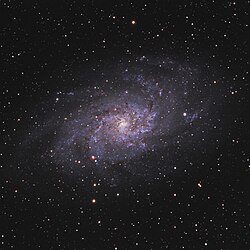The Sérsic profile (or Sérsic model or Sérsic's law) is a mathematical function that describes how the intensity of a galaxy varies with distance from its center. It is a generalization of de Vaucouleurs' law. José Luis Sérsic first published his law in 1963.[1]

Definition
The Sérsic profile has the form

where 




Today, it is more common to write this function in terms of the half-light radius, Re, and the intensity at that radius, Ie, such that
where 









Applications


Most galaxies are fit by Sérsic profiles with indices in the range 1/2 < n < 10.The best-fit value of n correlates with galaxy size and luminosity, such that bigger and brighter galaxies tend to be fit with larger n.[5][6]Setting n = 4 gives the de Vaucouleurs profile:

Sérsic profiles can also be used to describe dark matter halos, where the Sérsic index correlates with halo mass.[10][11]
Generalizations of the Sérsic profile
The brightest elliptical galaxies often have low-density cores that are not well described by Sérsic's law. The core-Sérsic family of models was introduced[12][13][14] to describe such galaxies. Core-Sérsic models have an additional set of parameters that describe the core.
Dwarf elliptical galaxies and bulges often have point-like nuclei that are also not well described by Sérsic's law. These galaxies are often fit by a Sérsic model with an added central component representing the nucleus.[15][16]
The Einasto profile is mathematically identical to the Sérsic profile, except that 



See also
References
External links
- Stellar systems following the R exp 1/m luminosity law A comprehensive paper that derives many properties of Sérsic models.
- A Concise Reference to (Projected) Sérsic R1/n Quantities, Including Concentration, Profile Slopes, Petrosian Indices, and Kron Magnitudes.
